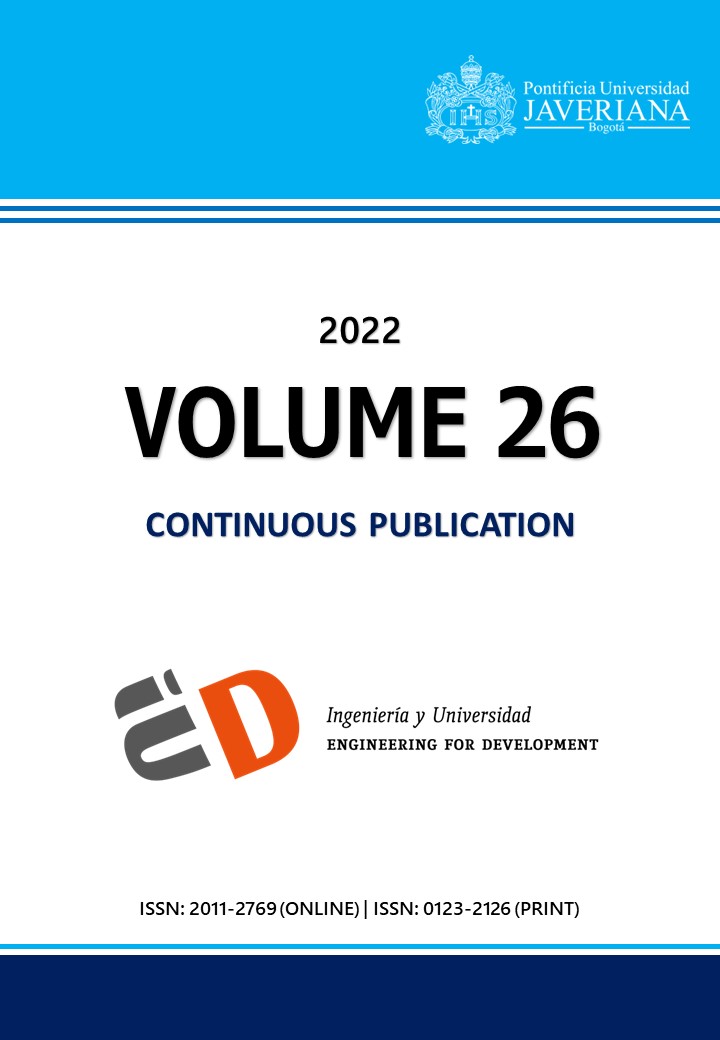Resumen
Objetivo: Proponer un criterio para determinar el tamaño de muestra en simulaciones estocásticas de MC (Monte Carlo) y MCMC (Markov chain Monte Carlo), garantizando una determinada precisión en la estimación de parámetros. Se busca que la precisión se garantice de forma adimensional. Materiales y métodos: El presente artículo propone un criterio buscando cumplir con el objetivo planteado. Además, de una metodología para la aplicación del mismo. Resultados y discusión: Se presenta la aplicación de la metodología en 3 contextos diferentes: Simulación de MC en que la muestra de interés presenta variabilidad moderada, simulación de MC en que la muestra de interés presenta variabilidad excesiva y simulación de MCMC. En todos los casos se obtienen adecuadas estimaciones del número de corridas MC y MCMC a partir de muestras relativamente pequeñas. Además, la aplicación de la metodología representa únicamente un costo computacional adicional marginal. Conclusiones: El criterio presentado en este artículo permite determinar el tamaño de muestra en simulaciones estocásticas, garantizando precisión adimensional en la estimación de parámetros.
C. Robert and G. Casella, Monte Carlo statistical methods, Springer Science & Business Media, 2004, https://doi.org/10.1007/978-1-4757-4145-2
G. Fishman, Monte Carlo: concepts, algorithms, and applications, Springer Science & Business Media, 2013.
J. S. Liu, Monte Carlo strategies in scientific computing, Springer Science & Business Media, 2008, https://doi.org/10.1007/978-0-387-76371-2
S. Ross, Simulation, 5th ed., Elsevier Science, 2012.
D. Gamerman and H. F. Lopes, Markov chain Monte Carlo: stochastic simulation for Bayesian inference, Chapman and Hall/CRC, 2006.
B. A. Berg and A. Billoire, Markov chain Monte Carlo simulations, Wiley Encyclopedia of Computer Science and Engineering. Wiley Online Library, 2007.
C. Forastero, L. Zamora, D. Guirado a A. Lallena, “A Monte Carlo tool to simulate breast cancer screening programmes,” Physics in Medicine & Biology, vol. 55, no. 17, p. 5213, 2010, https://doi.org/10.1088/0031-9155/55/17/021
H. MacGillivray, R. Dodd, B. McNally, J. Lightfoot, H. Corwin and S. Heathcote, “Monte-Carlo simulations of galaxy systems,” Astrophysics and Space Science, vol. 81, no. 1-2, pp. 231-250, 1982, https://doi.org/10.1007/BF00683346
T. Flouri, X. Jiao, B. Rannala and Z. Yang, “A Bayesian implementation of the multispecies coalescent model with introgression for phylogenomic analysis,” Molecular Biology and Evolution, vol. 37, nº 4, pp. 1211-1223, 2020, https://doi.org/10.1093/molbev/msz296
C. L. Ritt, J. R. Werber, A. Deshmukh and M. Elimelech, “Monte Carlo simulations of framework defects in layered two-dimensional nanomaterial desalination membranes: implications for permeability and selectivity,” Environmental Science & Technology, vol. 53, nº 11, pp. 6214-6224, 2019, https://doi.org/10.1021/acs.est.8b06880
I. Ciufolini and A. Paolozzi, “Mathematical prediction of the time evolution of the COVID-19 pandemic in Italy by a Gauss error function and Monte Carlo simulations,” The European Physical Journal Plus, vol. 135, nº 4, p. 355, 2020, https://doi.org/10.1140/epjp/s13360-020-00383-y
R. Al, C. R. Behera, K. V. Gernaey and G. Sin, “Stochastic simulation-based superstructure optimization framework for process synthesis and design under uncertainty,” Computers & Chemical Engineering, Vol. 143, pp. 107-118, 2020, https://doi.org/10.1016/j.compchemeng.2020.107118
E. Spitoni, K. Verma, V. S. Aguirre and F. Calura, “Galactic archaeology with asteroseismic ages-II. Confirmation of a delayed gas infall using Bayesian analysis based on MCMC methods,” Astronomy & Astrophysics, vol. 635, p. A58, 2020, https://doi.org/10.1051/0004-6361/201937275
O. Jones, R. Maillardet and A. Robinson, Introduction to scientific programming and simulation using R, Chapman and Hall/CRC, 2014.
A. E. Raftery and S. Lewis, How many iterations in the gibbs sampler? In J. M. Bernardo, M. J. Bayarri, J. O. Berger, A. P. Dawid, A. F. M. Smith, eds., Bayesian Statistics, vol. 4, Oxford University Press, 1992.
I. Lerche and B. S. Mudford, “How many Monte Carlo simulations does one need to do?,” Energy exploration & exploitation, vol. 23, no. 6, pp. 405-427, 2005, https://www.jstor.org/stable/43754693
F. E. Ritter, M. J. Schoelles, K. S. Quigley and L. C. Klein, “Determining the number of simulation runs: Treating simulations as theories by not sampling their behavior,” in L. Rothrock and S. Narayanan (eds.), Human in the loop simulations, Springer, 2011, pp. 97-116.
M. Liu, “Optimal Number of Trials for Monte Carlo Simulation,” VRC-Valuation Research Report, 2017.
L. T. Truong, M. Sarvi, G. Currie and T. M. Garoni, “How many simulation runs are required to achieve statistically confident results: a case study of simulation-based surrogate safety measures,” 2015 IEEE 18th International Conference on Intelligent Transportation Systems, 2015, pp. 274-278, https://doi.org/10.1109/ITSC.2015.54
G. Hahn, “Sample Sizes for Monte-Carlo Simultation,” IEEE Transactions on Systems Man and Cybernetics, no. 5, p. 678, 1972. https://ieeexplore.ieee.org/stamp/stamp.jsp?arnumber=4309200
W. Oberle, Monte Carlo Simulations: Number of Iterations and Accuracy, Army Research Lab Aberdeen Proving Ground Md Weapons and Materials Research, 2015, https://apps.dtic.mil/sti/pdfs/ADA621501.pdf
M. D. Byrne, “How many times should a stochastic model be run? An approach based on confidence intervals,” Proceedings of the 12th International conference on cognitive modeling, Ottawa, 2013.
R. J. Serfling, Approximation theorems of mathematical statistics, John Wiley & Sons, 2009.
M. Bland, “Estimating mean and standard deviation from the sample size, three quartiles, minimum, and maximum,” International Journal of Statistics in Medical Research, vol. 4, no. 1, pp. 57-64, 2014, https://doi.org/10.6000/1929-6029.2015.04.01.6
C. Kipnis and S. S. Varadhan, “Central limit theorem for additive functionals of reversible Markov processes and applications to simple exclusions,” Communications in Mathematical Physics, vol. 104, no. 1, pp. 1-19, 1986, https://doi.org/10.1007/BF01210789
C. J. Geyer, “Practical markov chain Monte Carlo,” Statistical Science, vol. 7, no. 4, pp. 473-483, 1992, https://doi.org/10.1214/ss/1177011137
M. A. Capistrán, J. A. Christen and S. Donnet, “Bayesian analysis of ODEs: solver optimal accuracy and Bayes factors,” SIAM/ASA Journal on Uncertainty Quantification, vol. 4, no. 1, pp. 829--849, 2016, https://doi.org/10.1137/140976777
J. A. Christen and C. Fox, “A general purpose sampling algorithm for continuous distributions (the t-walk),” Bayesian Analysis, vol. 5, no. 2, pp. 263-281, 2010, https://doi.org/10.1214/10-BA603

Esta obra está bajo una licencia internacional Creative Commons Atribución 4.0.
Derechos de autor 2022 Juan Daniel Molina-Muñoz, MSc, José Andrés Christen, PhD



